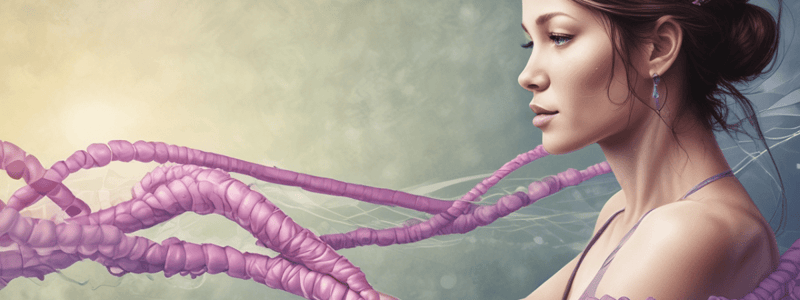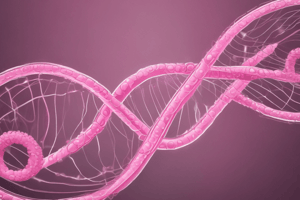Podcast
Questions and Answers
What is the percentage of breast cancer cases that are inherited?
What is the percentage of breast cancer cases that are inherited?
- 50-80%
- 30-50%
- 5-7% (correct)
- 95%
What is the primary function of BRCA proteins?
What is the primary function of BRCA proteins?
- Inducing apoptosis
- Inhibiting oestrogen receptor gene expression
- Stimulating cell proliferation
- Regulating cell cycle and DNA repair (correct)
What is the result of loss of PTEN activity?
What is the result of loss of PTEN activity?
- Unregulated cell proliferation and carcinogenesis (correct)
- Inhibition of cell proliferation and apoptosis
- Regulation of cell cycle and DNA repair
- Suppression of oestrogen receptor gene expression
What is the characteristic of PTEN mutations in Cowden syndrome?
What is the characteristic of PTEN mutations in Cowden syndrome?
What is the estimated frequency of Cowden syndrome in the population?
What is the estimated frequency of Cowden syndrome in the population?
What is the percentage of prostate cancers that have mutant PTEN?
What is the percentage of prostate cancers that have mutant PTEN?
Which protein binds to responsive elements in gene promoters as a tetramer?
Which protein binds to responsive elements in gene promoters as a tetramer?
What is the consequence of a mutation in p53 alleles?
What is the consequence of a mutation in p53 alleles?
What is the role of p21 in cell cycle regulation?
What is the role of p21 in cell cycle regulation?
What is the consequence of extensive DNA damage in a cell?
What is the consequence of extensive DNA damage in a cell?
What is the role of p53 in angiogenesis?
What is the role of p53 in angiogenesis?
What is the characteristic of Li-Fraumeni syndrome (LFS)?
What is the characteristic of Li-Fraumeni syndrome (LFS)?
What is the result of some specific p53 mutations?
What is the result of some specific p53 mutations?
What is the effect of HPV E7 on Rb?
What is the effect of HPV E7 on Rb?
What is the role of p21 in DNA synthesis and repair?
What is the role of p21 in DNA synthesis and repair?
What is the consequence of a lack of functional p53?
What is the consequence of a lack of functional p53?
What is the function of HPV E6 in infected cells?
What is the function of HPV E6 in infected cells?
What is the impact of having both Arg alleles in the p53 gene?
What is the impact of having both Arg alleles in the p53 gene?
What is the goal of combination therapies in cancer treatment?
What is the goal of combination therapies in cancer treatment?
Why do tumour cells vary in their sensitivity to therapy?
Why do tumour cells vary in their sensitivity to therapy?
What is the goal of chemotherapy in cancer treatment?
What is the goal of chemotherapy in cancer treatment?
What is the purpose of clinical trials in drug development?
What is the purpose of clinical trials in drug development?
Flashcards
BRCA1 & BRCA2: Function and Cancer Risk
BRCA1 & BRCA2: Function and Cancer Risk
BRCA1 and BRCA2 are genes located on chromosomes 17 and 13, respectively. They are involved in DNA repair, specifically addressing double-strand breaks. Mutations in these genes can significantly increase the risk of breast and ovarian cancer.
PTEN: What it does
PTEN: What it does
PTEN is a gene that encodes a phosphatase enzyme. This enzyme helps regulate cell growth by controlling the levels of a signaling molecule called PIP3. Loss of PTEN function can lead to excessive cell growth and cancer development.
PTEN & Cowden Syndrome
PTEN & Cowden Syndrome
Mutations in the PTEN gene are linked to Cowden syndrome, a rare genetic disorder characterized by an increased risk of various cancers, including breast, prostate, and thyroid cancers.
p53: The Ultimate Cell Cycle Regulator
p53: The Ultimate Cell Cycle Regulator
Signup and view all the flashcards
p53 Activation
p53 Activation
Signup and view all the flashcards
p53 & Cell Cycle Checkpoints
p53 & Cell Cycle Checkpoints
Signup and view all the flashcards
p53 & Apoptosis
p53 & Apoptosis
Signup and view all the flashcards
p53 & Angiogenesis
p53 & Angiogenesis
Signup and view all the flashcards
p53 Mutations: Types
p53 Mutations: Types
Signup and view all the flashcards
Li-Fraumeni Syndrome
Li-Fraumeni Syndrome
Signup and view all the flashcards
Dominant-Negative Effect
Dominant-Negative Effect
Signup and view all the flashcards
Viral Interference with Tumor Suppressors
Viral Interference with Tumor Suppressors
Signup and view all the flashcards
Conventional Cancer Treatments
Conventional Cancer Treatments
Signup and view all the flashcards
Molecular Therapies: Precision Medicine
Molecular Therapies: Precision Medicine
Signup and view all the flashcards
Tumor Heterogeneity
Tumor Heterogeneity
Signup and view all the flashcards
How Chemotherapy Works
How Chemotherapy Works
Signup and view all the flashcards
Therapeutic Index
Therapeutic Index
Signup and view all the flashcards
Clinical Trial Phases
Clinical Trial Phases
Signup and view all the flashcards
Study Notes
BRCA1 and BRCA2
- BRCA1 located on chromosome 17 and BRCA2 on chromosome 13; both exhibit autosomal recessive inheritance.
- Increased familial risk of breast and ovarian cancer due to inherited mutations.
- Individual lifetime risk for breast cancer is 50-80% and for ovarian cancer 30-50%.
- BRCA proteins are critical for DNA repair mechanisms, particularly in addressing double-strand breaks.
PTEN and Tumor Suppression
- PTEN gene encodes a phosphatase that dephosphorylates PIP3 to PIP2, antagonizing PI3 kinase activity.
- Loss of PTEN leads to unregulated cell proliferation and potential carcinogenesis.
- Germline mutations in PTEN are linked to Cowden syndrome, presenting growths and increased cancer risk, including breast, prostate, and thyroid cancers.
p53 and Cell Cycle Regulation
- p53 is a vital tumor suppressor that regulates the expression of over 50 genes involved in the cell cycle and apoptosis.
- Normal function requires binding with Mdm2; phosphorylation alters this interaction, allowing p53 accumulation.
- p21, mediated by p53, inhibits Cyclin D/Cdk4 to pause the cell cycle at the G1/S checkpoint for DNA repair.
p53 in Apoptosis and Angiogenesis
- p53 facilitates the expression of pro-apoptotic genes and can induce cellular apoptosis after extensive DNA damage.
- The activation of caspases leads to apoptotic cell death; mutations in the p53 gene can hinder this pathway.
- p53 also regulates genes that inhibit angiogenesis, such as thrombospondin.
p53 Gene Mutations
- Most mutations in the p53 gene are missense mutations affecting the DNA binding domain, leading to loss of function.
- Li-Fraumeni syndrome is characterized by inherited p53 mutations, resulting in a 25x increased cancer risk by age 50.
- Some mutations may create dominant negative effects, impairing wild-type p53 function.
Viral Interference with Tumor Suppressors
- Oncogenic viruses, like HPV, produce proteins that inhibit tumor suppressor proteins; HPV E7 inactivates Rb and E6 inactivates p53.
- E6 and E7 facilitate cell proliferation and contribute to cancer development.
Cancer Treatment Approaches
- Conventional treatments include surgery, radiotherapy, and chemotherapy; newer molecular therapies are emerging.
- Surgical excision is often combined with other treatments to target remaining cancer cells or metastases.
- Radiotherapy aims to induce DNA damage; however, it can also affect rapidly dividing normal cells.
Tumor Sensitivity to Therapy
- Tumor heterogeneity leads to varying sensitivity to treatments based on cell type, proximity to blood supply, and mutations.
- Chemotherapy aims for maximum efficacy with minimal side effects; the therapeutic index assesses the safety of drugs.
Chemotherapeutic Agents and Clinical Trials
- Chemotherapy disrupts DNA, RNA, and protein functions to induce apoptosis, though it can also affect normal proliferating cells.
- Drug testing progresses through multiple phases, including cell culture, animal models, and clinical trials (Phase I-III), evaluating efficacy and safety.
Studying That Suits You
Use AI to generate personalized quizzes and flashcards to suit your learning preferences.



